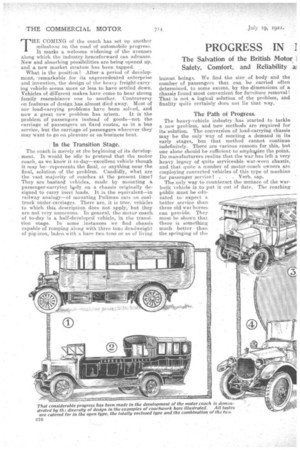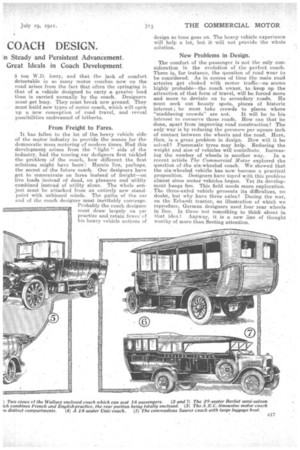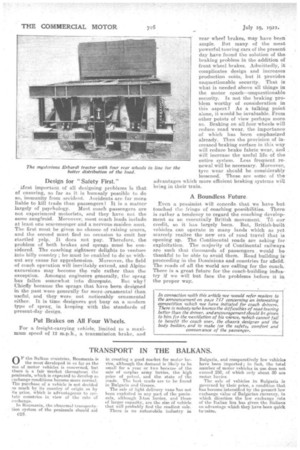PROGRESS • IN I
Page 12

Page 13

Page 14

If you've noticed an error in this article please click here to report it so we can fix it.
COACH DESIGN.
THE COMING of the coach has set up another milestone on the road of automobile progress. It marks a welcome widening of the avenues along which the industry henceforward can advance. New and absorbing possibilities are being opened up, and a new market stratum has been tapped.
What is the position? After a period of development, -remarkable for its unprecedented enterprise and invention, the design of the heavy freight-carrying vehicle seems more or less to have settled down. Vehicles of different makes have come to bear strong family resemblance one to another. Controversy on features of design has almost died away. Most of our load-carrying problems have been solved, and now a great new problem has arisen. It is the problem of passengers instead of goods—not the carriage of -passengers on fixed routes, as in a bus service, but the carriage of passengers wherever they may want to go on pleasure or on. business bent.
i In the Transition Stage.
The coach is merely at the beginning of its development. It would be idle to pretend that the motor coach, as we know it to-day—excellent vehicle though it may be—represents the final, or anything near the final, solution of the problem. Candidly, what are the vast majority of coaches at the present. time? They are bastard vehicles, made by mounting a passenger-carrying hody on a chassis originally designed to carry inert loads. It. is the equivalent—in railway analogy—of mounting Pullman cars on coaltruck under-carriages. There are, it is true, vehicles to which this description does not apply, but they are not very numerous. In general, the motor coach, of to-day is a half-developed vehicle, in the transition stage. In some instances we find chassis capable of romping along with three tons deadweight of pig-iron, laden with a bare two tons or so of living human beings. We find the size of body and the number of passengers that can be carried often determined, to some extent, by the dimensions of a chassis found most convenient for furniture removal! That is not, a logical solution of the problem, and finality quite certainly does not lie that way.
The Pathof Progress.
The heavy-vehicle industry has started to tackle a new problem, and new methods are required for its solution. The conversion of load-carrying chassis may be the only way of meeting a demand in its early stages, but that method cannot continue indefinitely. There are various reasons far this, but one alone should be sufficient to emphvize the point. Do manufacturers realize that the war has left a very heavy legacy of quite serviceable war-worn chassis, and that quite a number of motor-coach owners are employing converted vehicles of this type of machine for passenger service.? . . . Verb. sap.
The only way to counteract the menace of the warbuilt vehicle is to put. it out of date. The coaching public must be educated to' expect a better service than these old war-horses can provide. They must be shown that there is something much better than the springing of the 3 ton W. D. lorry, and that the lack of comfort detectable in so many motor coaches now on the road arises from the fact that often the springing is that of a vehicle designed to carry a greater load than is carried normally by the coach. Designers must get busy. They must break new ground. They must build new types of motor coach, which will open up a new conception of road travel, and reveal possibilities undreamed of hitherto.
From Freight to Fares.
It has fallen to the lot of the heavy vehicle side of the motor industry to provide the means for the democratic mass motoring of modern times. Had this development arisen from the "light " side of the industry, had the touring car dedigners first tackled the problem of the coach, bow different the first solutions might have been Herein lies, perhaps, the secret of the future coaeh. Our designers have got to concentrate on fares instead of freight—on live loads instead of dead, on pleasure and utility • combined instead of utility alone. The whole sub ject must be attacked from an entirely new stand point with unbiased minds. The paths of the car and of the coach designer must inevitably converge. Probably the coach designer must draw largely on car practice and retain fewer cf Ills heavy vehicle notions of It1111111111111MMIMMIMIIIMII 1111111111!i design as time goes on. The heavy vehicle experience will help a lot, but it will not provide the whole solution.
New Problems in -Design.
The comfort of the passenger is not the only consideration in the evolution of the perfect coach. There is, for instance, the question of road wear to be considered. As in course of time the main road arteries get choked with motor traffic—as seems highly probable—the coach owner, to 'keep up the attraction of that form of travel, will be forced more and more to deviate on to secondary roads. He must seek out beauty spots,_ places of historic interest; he must take crowds to places where "Maddening crowds" are not. It will be to his interest to conserve those roads. How can that be done, apart from improving road construction? The only way is by reducing the pressure per square inch of contact between the wheels and the road. Here, then, is a great problem in design. How will it be solved ? Pneumatic tyres may help. Reducing the weight and size of vehicles will contribute. Increasing the number of wheels is another way. In a recent article The Commercial Motor explored the question of-the six-wheeled coach. We showed that the six-wheeled vehWle has now become a practical proposition. Designers have toyed with this problem almost since motor vehicles began. Yet its development hangs fire. This field needs more exploration. The three-axled vehicle presents its difficulties, no doubt, but why have three axles? During the war, on the Erhardt tractor, an illustration of which we reproduce, German designers used four rear wheels in line. Is there not something to think about in that idea ? Anyway, it is a new line of thought worthy of more than fleeting attention.
Design for "Safety First."
Idost important of all designing problems is that of ensuring, so far as it is humanly possible to do so, immunity from accident. Accidents are far more liable to kill trade than passengers! It is a matter largely of psychology. Most coach passengers are not experienced motorists, and they have not the same sangfroid. Moreover, most coach loads include, at least one scaremonger and a nervous maiden aunt. The first must be given no chance of raising scares, and the second must find no occasion to emit her startled yelp. It does not pay. Therefore, the problem of both brakes and swags must be considered. The coaching sightseer delights to venture into hilly country ; he must be enabled to do so without any cause for apprehension. Moreover, the field Of coach operation will inevitably extend, and Alpine excursions may become the rule rather than the exception. Amongst engineers generally, the sprag has fallen somewhat into disrepute. But why? Chiefly because the sprags that have been designed in the past were generally far more ornamental than useful, and they were not noticeably ornamental either. It is time designers got busy on a modern type of sprag, in keeping with the standards of present-day design.
Put Brakes on All Four Wheels.
For a freight-carrying vehicle, limited to a maximunr speed of 12 m.p.h., a transmission brake, and
I. rear wheel brakes, may have been I ample. But many. of the most powerful touring cars of the present day have found the solution of the braking problem in the addition of front wheel brakes. Admittedly, it complicates design and increases production costs, but it provides unquestionable security. That is what is needed above all things in the motor coach—unquestionable security. Is not the braking problem worthy of consideration in this aspect? As a talking point alone, it would be invaluable. From other points of view perhaps more so. Braking on all four wheels will reduce road wear, the importance of which has been emphasized already. Then the proyision of increased braking surface in this way will reduce brake fabric wear, and will increase the useful life of the entire system. Less frequent renewal will be necessary. Moreover, tyre wear should be considerably lessened: These are some of the advantages which more efficient braking systems will bring in their train.
A Boundless Future.
Even a pessimist will concede that we have but touched the fringe of coaching possibilities,. There is rather a tendency to regard the coaching development as an essentially British movement. TO our credit, so it has largely been. But, British-built . vehicles can operate in many lands which as yet scarcely realize the new era of road traVel that is opening up. The Continental roads are asking for exploitation. The majority of Continental railways are such that thousands of passengers . would be thankful to be able to avoid them. Road building is proceeding in the Dominions and countries far afield. The roads of all the world are calling for the coach. There is a great future for. the coach-building industry if we will but face the problems before it in the proper way.
































